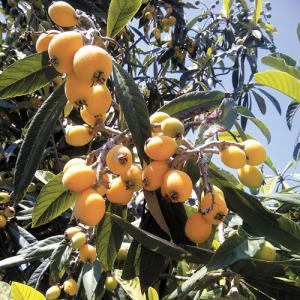Eating loquats has a noticeable sedative effect
Spring is a time to dream of the new year. There is an unusual plant that in Armenia is called New World because it ushers in the new world of spring.
Here we call them loquats. Their tiny white flowers bloom in the fall or early winter in groups or panicles at the ends of the branches. You can smell the delicate aroma from quite a ways, and one plant will scent a room. Before they open, the flower buds have a most unusual rusty-wooly texture.
The flowers develop into clusters of five to 25 fruits at the ends of the branches. The 2-inch-long fuzzy fruits ripen to a golden yellow. The soft, sweet fruit is similar to apricots. Inside each fruit are two or three large, inedible brown seeds. This small tropical tree has evergreen, foot-long dark green leaves with a slight white tinge underneath. Christmas loquat usually sets fruit within a year or two.
Since loquats are only hardy to USDA Zones 8-10, we need to grow them in containers in Delaware or most of the country. The loquat Christmas (Eriobotrya japonica hybrid) is a perfect plant to grow in pots because it blooms and sets fruit easily while very young.
Loquats are usually pollinated by bees and other insects. Indoors you can pollinate the flowers by hand using a fine artist brush.
Loquats stand up fairly well to wind, but be sure the pot is heavy enough to not fall over. While they grow best in full sun, they can tolerate some shade.
Loquats need average potting soil with good drainage. You can mix perlite or sand into any soil to increase drainage.
For best-quality fruit, water regularly until water runs out of the drainage hole. Let the soil dry out slightly between waterings. Loquats cannot tolerate standing water.
Fertilize your potted loquats with a good slow-release organic fertilizer. Avoid too much nitrogen because it will reduce flowering.
You can prune right after harvest, keeping terminal shoots to a minimum.
Always cut out any crossing branches, and thin out thick growth to let light and air into the center of the tree. Don't worry about cutting out too much; loquats seem to rebound easily from severe pruning.
Like most of its relatives, the seeds, or pips, and young leaves are slightly poisonous. They contain tiny amounts of cyanogenic glycosides (including amygdalin) which release cyanide if eaten.
The concentration is so low that along with the bitter taste of the seeds, poisoning is rare or unheard of.
What doesn't kill you makes you stronger, and loquat syrup is used in Chinese medicine to soothe the throat, and it is a popular ingredient in cough drops.
Loquat leaves are used as both a demulcent and an expectorant, and help soothe the respiratory and digestive tracts.
If the thought of eating soft, sweet loquats that you grow yourself in pots makes you dreamy, it might not be your imagination. Eating lots of loquats has a proven noticeable sedative effect, one that lasts up to 24 hours. And that can make a gardener's dreams come true.




















































